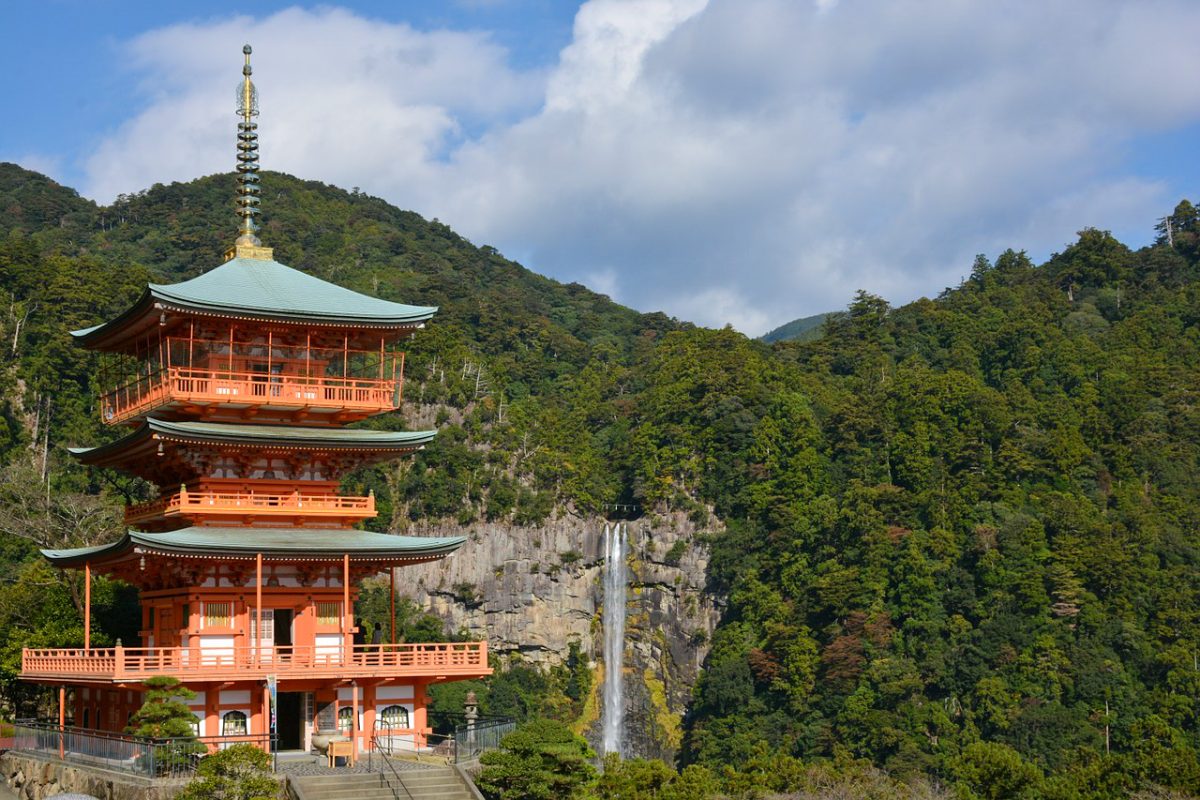What is the Kumano Kodo pilgrimage? The term kodo means “old ways,” and Kumano Kodo refers to a network of hiking trails laced throughout the southern reaches of the Kansai region, on the Kii Peninsula. The trails have been used for more than 1,000 years and are designated as a UNESCO World Heritage Site.
The Kodo trails were originally used by religious pilgrims from Kyoto, Osaka, and other parts of Japan to visit the various sacred sites of the Kii Peninsula. These sacred shrines are called Kumano Sanzan and include the Hongu Taisha, Nachi Taisha, and Hayatama Taisha.
The trails also provide access to Kyoto and other locations of religious importance, such as the Koyasan headquarters of Shingon Buddhism, the Omine and Yoshino locations of mountain worship, and the most important shrine in Japan, called the Ise Shrine.
The purpose of the trails went beyond transportation; the travel itself was meant to be a spiritual experience, as the pilgrim braved dangerous yet beautiful mountain terrain.
Table of Contents
Kumano Kodo main trails
While a few of the original trails no longer remain, five have been well preserved and may be accessed by travelers. Perhaps the easiest of the trails to hike is the Nakahechi. This trail winds through hills, forests, and villages. From Takajiri Oji to Hongu, it is about 30 kilometers in length and can be completed on foot in two days. Chikatsya Oji provides a convenient overnight stop with several minshuku, or family operated bed and breakfasts. The trail ends at the shrine Hongu Taisha, with a view of the large torii gate.
Okechi trail
The Ohechi is a coastal trail that was in vogue from the tenth to the fifteenth century. At that time, an estimated 30,000 people traversed the trail each year. Spanning the coast from Tanabe to the Nachi Taisha, modern development has nearly erased this historic trail.
Iseji trail
The Iseji trail also hugs the coast from the Ise Shrine in the Mie Prefecture to the Hongu Taisha and Hayatama Taisha. This trail has also been largely covered by new construction, but picturesque stretches of the original stone path still exist in Owase City’s Magose Pass and Kumano City’s heavily forested Matsumoto Pass.
Kohechi trail
The Kohechi trail connects Koyasan and Mount Koya with the Kumano Sanzan. This is one of the most challenging of the trails, originally traversed by Buddhist monks from the temple on Mount Koya. If you wish to experience this trail, you must make careful advance planning. You may desire to sleep on the mountainside, as inns can only be reached by descending from the trail into nearby villages.
Omine-Okugake trail
The Omine Okugake route passes through Mount Omine and the Nara mountains, running between Yoshino and Kumano.
This ancient trail was used by members of the Shugendo sect of mountain worship, and it is also difficult, mountainous, and at times, dangerous. There are few villages along the way and Yoshino cherry trees are particularly beautiful in the spring
Kumano Kodo map

How to get to Kumano
Kumano is easily accessible from many major cities, such as Osaka, Kyoto, Tokyo, and Nagoya, as well as the Kansai International Airport, using the extensive rail and bus systems. When using the Shinkansen trains, the entire trip will be covered by your Japan Rail Pass.
Tokyo to Kumano
If traveling from Tokyo, you have two travel options. You could first take the JR Tokaido Shinkansen to Shin-Osaka Station, a trip of two and a half to three hours. Or, you could take the Shinkansen to Nagoya, a trip of one and a half to two hours. From either Osaka or Nagoya, proceed as described below to get to the Kumano region.
Osaka to Kumano
From Shin Osaka Station, take the JR limited express to the Kii Peninsula. The train will make several stops on the western side of the peninsula, including Kii-Tanabe Station, Shirahama Station, Kushimoto Station, and Kii-Katsuura Station.
Nagoya to Kumano
From Nagoya, take the JR Nanki limited express train to the eastern side of Kii Peninsula. The train will stop at Owase Station, Kumano-shi Station, Shingu Station, and Kii-Katsuura Station.
The Ise Kumano Tourist Pass may be a good option for train travel to and around Kumano. The pass costs ¥11,000 for adults and ¥5,500 for children, and is valid for five consecutive days. You will be able to use the pass on all JR conventional rail lines, as well the Sangu Line, the Kansai Main Line to Osaka, and the Kansai Airport Line. The pass also affords bus transportation around the Kii Peninsula on the Mie Kotsu and Kumano Kotsu buses.
No matter the pilgrimage routes you choose to explore, your next Japanese vacation is sure to be one of wonder and adventure, made even more affordable and accessible thanks to your JR Pass.
